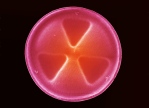1738 – Switzerland
1859 – England
‘Gases are composed of molecules which are in constant random motion and their properties depend upon this motion’
The volume of a gas is simply the space through which molecules are free to move. Collisions of the molecules with each other and the walls of a container are perfectly elastic, resulting in no decrease in kinetic energy. The average kinetic energy of a gas increases with an increase in temperature and decreases with a decrease in temperature. The theory has been extended to provide a model for two states of matter – liquids and solids.
Bernoulli had a great advantage over DEMOCRITUS. He knew that free atoms were more than simply tiny grains flying though space; they were tiny grains flying through space and obeying NEWTON’s Laws of Motion.
Bernoulli proposed a ‘bombardment theory’, which stated that a gas consisted of tiny particles in rapid, random motion like a swarm of angry bees. He realized that in the case of such a gas visualized as a host of tiny grains in perpetual frenzied motion, the atoms hammering relentlessly on the walls of any containing vessel would produce a force by bombarding the container. The effect of each individual impact would of course be vanishingly small. The effect of billions upon billions of atoms, hammering away incessantly, however, would be to push the walls back. A gas made of atoms would exert a jittery force that we would detect as a ‘pressure’.
Heating a gas would make its particles move faster.
The pressure of a gas such as steam was easy to measure using a piston in a hollow container. This was essentially a moveable wall. To deduce how the pressure of a gas would be affected by different conditions, Bernoulli first made some simplifying assumptions. He assumed the atoms were very small compared to the gulf between them. This allowed Bernoulli to ignore any force – whether of attraction or repulsion – that existed between them, as being unlikely to be ‘long range’. (This is an ‘ideal’ or ‘perfect’ gas. The behaviour of a real gas may differ from the ideal, for example at very high pressure). With the motion of each atom unaffected by its fellows, Newton’s laws dictated that it should fly at a constant speed in a straight line. The exception was when it slammed into a piston or the walls of the container. Bernoulli assumed that in such a collision a gas atom bounced off the walls of the surface without losing any speed, in the process imparting a miniscule force to the wall.
What would happen if the volume of the gas were reduced by applying an outside force to the piston? If the gas were reduced to half its original volume, the atoms would now have to fly only half as far between collisions, in any given time they would collide with the piston twice as many times and would exert twice the pressure. Similarly, if the gas were compressed to a third of its volume, its pressure would triple. This had been observed by ROBERT BOYLE in 1660 and named Boyle’s Law.
What would happen to the pressure of gas in a closed cylinder if the gas were heated while its volume remained unchanged? Exploiting the insight that the temperature of a gas was a measure of how fast on average its atoms were flying about, that when a gas was heated, its atoms speeded up, he deduced that as the atoms would be moving faster they would collide with the piston more often and create a greater force. Consequently the pressure of the gas would rise. This was observed by the French scientist JACQUES ALEXANDRE CESARE CHARLES in 1787, and christened Charles’ law.
After 120 years MAXWELL polished Bernoulli’s ideas into a rigorous mathematical theory. In Germany, LUDWIG BOLTZMANN championed the atomic hypothesis, but was refuted by the Austrian ERNST MACH, who was convinced that science should not concern itself with any feature of the world that could not be observed directly with the senses.
BERNOULLI’S PRINCIPLE
‘As the velocity of a liquid or gas increases, its pressure decreases; and when the velocity decreases, its pressure increases’
At a narrow constriction in a pipe or tube, the speed of a gas or liquid is increased, but its pressure is decreased, according to Bernoulli’s principle. This effect is named the Venturi effect (and a pipe or tube with a narrow constriction the Venturi tube) after the Italian G.B. Venturi (1746-1822) who first observed it in constrictions in water channels. An atomiser works on the same principle.
The principle is expressed as a complex equation, but it can be summed up simply as the faster the flow the lower the pressure.
An aircraft wing’s curved upper surface is longer than the lower one, which ensures that air has to travel further and so faster over the top than it does below the wing. Hence the air pressure underneath is greater than on top of the wing, causing an upward force, called lift.

 TIMELINE
TIMELINE
 MECHANICS
MECHANICS



 TIMELINE
TIMELINE









